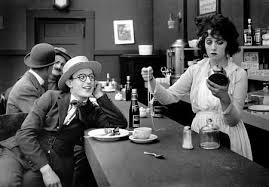Adapted from my book Chain of Fools: Silent Comedy and Its Legacies from Nickelodeons to Youtube, released by Bear Manor Media,
100 years ago today (September 9, 1917) Harold Lloyd released his first “glasses” comedy Over the Fence (1917), directed by J. Farrell MacDonald, whom Lloyd had met while working on L. Frank Baum’s Oz films three years earlier. Previous to this experiment, Lloyd had played other screen characters named Willie Work and Lonesome Luke. The latter character had become quite successful by this time, but Lloyd felt limited by the character’s broad clownishness. He wanted to attempt something more realistic, that the audience could relate to more. It was a gamble.
Lloyd wrote in his autobiography An American Comedy of admiring a bespectacled but feisty parson in some long-forgotten dramatic picture, and of his decision to try a new, more realistic character based on the same idea. His solution is often referred to as “the Glasses Character” – a single pair of spectacles comprising the sum total of his comic mask. This most minimal of costumes made him far less clowny than nearly every other silent comedian, and yet it its effect was most definitely real.

For some insight on the impact that these simple glasses made on his comic persona, watch Lloyd in the Mack Sennett film Courthouse Crooks. He’s a nice young man, earnest, apparently honest. He plays the part without glasses. (Lloyd didn’t wear glasses in real life at the time; the famous spectacles were really just a pair of empty frames). Without the specs Lloyd loses something. In fact, he loses everything. He scarcely registers, there’s not much of a character there. Among other things, the glasses made Harold seem vulnerable, a natural prey for bullies – whom he would always rise to overcome at a picture’s climax. He took such punishment in the earliest scenes of a film that the audience could only feel for him. He became so expert at this storytelling strategy that critic Walter Kerr called him “the architect of sympathy.”
Lloyd was essentially playing a version of himself, a living embodiment of “Pluck and Luck”, the title of the Horatio Alger novel that most seems to express the Lloyd philosophy. It seems likely that he played the character because he knew him so well from the inside. In 1917, he began a series of one reel shorts with this approach, producing them at the very same time he is releasing two reel Lonesome Luke films. He was hedging his bets – a very cautious fellow.
Lloyd needn’t have worried. His first “Glasses” picture Over the Fence, is a most auspicious beginning. The costume is transitional. Yes he wears the glasses, but he still retains an old fashioned flowing cravat, whiteface and a silly hat, making him look only slightly less outre than his co-star Snub Pollard. Some of these touches would remain as late as 1919. But he already has this new character down, brisk and breezy, full of pep and spirit. He and Pollard play two store clerks who are butting heads over the same girl (Bebe Daniels). When Snub steals Harold’s baseball tickets and brings Bebe to the game himself, Harold one-ups him by sneaking into the locker room, suiting up, and pitching a winning game. For good measure, he beats up Snub and the entire baseball team, and, needless to say, wins the heart of Bebe.
This is already more enjoyable that any Lonesome Luke picture. You’ll find no bigger fan of broad, ridiculous clowning than this commentator. I live for the over-the-top comedy of Ford Sterling, Ben Turpin or for that matter, Snub Pollard. But such contortionism really wasn’t Lloyd’s métier. He was much more confident, comfortable and inspired in exaggerating real human behavior than playing the grotesque. He was simply funnier this way.
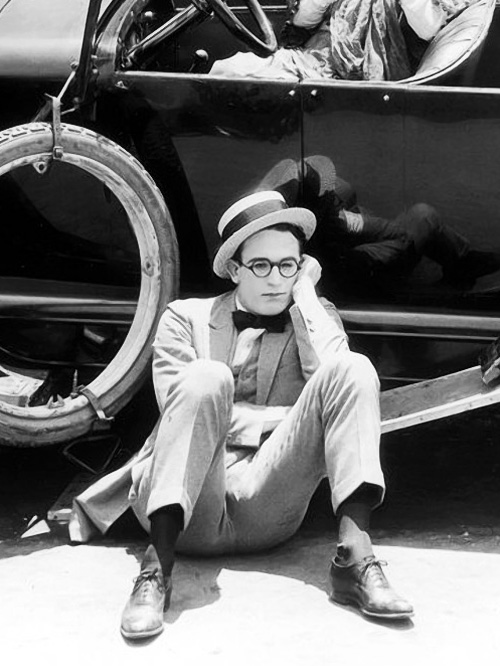
The transition wasn’t seamless. Many of the early offerings seem like they would have been just as good in Lonesome Luke mode. In Are Crooks Dishonest? (1918) Harold and Snub are a pair of roving con artists, a far cry from the boy next door. The City Slicker (1918) is a crude affair in which Harold is hired to spruce up a rural inn, causing much chaos in the process. The Harold we know and love would have had the hotel up and running ship-shape by the closing credits, but in this film he just makes a hash of things. And several pictures, Two Gun Gussie, Billy Blazes Esq., An Easterner Westerner, Captain Kidd’s Kids and His Royal Slyness (all 1918-1920) are clear borrowings of the Fairbanks formula, fantasies that send Harold’s young man off on heroic storybook adventures.
But gradually Lloyd begins to find his voice. He dropped the last vestiges of clownishness from his costume and went completely modern. The vastly more primitive buffoon Snub Pollard left the series to star in his own shorts. By 1919, Lloyd’s Glasses Character had made the transition to two-reelers, and increasingly Lloyd was honing in on story elements that were his alone.
A new template is established in the very earliest “Glasses” pictures. If Lonesome Luke had been an anti-Chaplin in outward appearance (tight trousers rather than baggy ones, two black squares for a mustache instead one), Lloyd’s new character would be one in more substantive ways. If Chaplin’s Little Fellow is an anarchist and an outsider, Lloyd’s character would be a conformist, an aspiring member of the accepted social order. The new improved Lloyd saw no need to equate comedy with being transgressive. As Luke, he had pretty much worked Chaplin’s side of the street: defied policemen, leered at girls, and shoved strangers at random. By contrast, the Glasses Character generally seems to have a moral compass. This boy is nice. For the most part he plays by the rules. When he breaks them, he does it in a way we ourselves may sometimes do – as a lapse, an exception rather than the rule. He doesn’t thumb his nose, kick children, spit at people. He’s definitely not a masher. He genuinely falls in love with his love-interest; his intentions involve more than a roll in the hay, but a walk down the aisle.
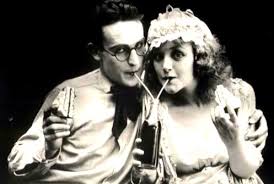
And unlike Chaplin, he usually gets her. As in Douglas Fairbanks’ comedies, Lloyd gives us happy endings. He wins the game, he lands the job, he gets the girl. And there is a reason for that. It’s not because he is privileged and entitled. It is never handed to him on a silver platter. He has to fight for it. But whereas Fairbanks’ character is generally a virile specimen who simply has to turn around his attitude, the Boy with the Glasses has the added hurdle of being physically puny. When he finds the gumption it’s more of a miracle and thus more comic.
Sometimes the hurdles to overcome are external. Sometimes they are within his own character. He can be shy, weak, cowardly, even lazy. If the only way to get what he wants is by licking these defects, he does so. Like Fairbanks, Lloyd was a poster boy for The Strenuous Life, for vigorous Americanism. Teddy Roosevelt would have approved of a film like A Sailor Made Man (1921), the whole plot of which essentially concerns a young man joining the service and obtaining some character.
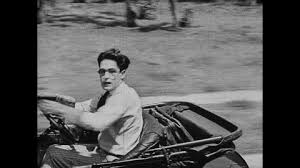
In By the Sad Sea Waves (1917) Harold is compelled to become a lifeguard (and as a corollary, save lives) to impress Bebe. In Bliss (1917), as Chaplin had often done, he masquerades as a nobleman. In The Flirt (1917), he is so taken with a girl he has just met that he takes a job at the lunch counter where she works just to be close to her. He will go to any length to land a promotion, make a touchdown, close a sale.
Persistence is the key to his character. Undergoing the world’s toughest lodge initiation in Pay Your Dues (1919). Overcoming endless car troubles to make it to an amateur theatrical in Get Out and Get Under (1920). Simply trying to make a call from a pay phone in Number, Please (1920). He is, as the title of one of his films from 1918 has it, The Nonstop Kid. In that picture, he is not at all discouraged to learn that his girl’s father wants her to marry a certain professor. He simply seeks the prof out, disposes of him and assumes his identity, to the point of giving a musical recital in spite of a lack of talent or training. (Solution? He lip syncs to a gramophone). In Bumping into Broadway (1919), he plays a poverty-stricken playwright. In order to get his manuscript to a producer, he hides in a prop grandfather clock and has himself delivered right onto the stage. In Ask Father (1919), he must make it past a very determined secretary in order to ask a father for his daughter’s hand. After countless tries, he simply climbs up the façade of the building and climbs in the window.
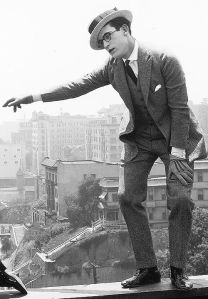
Nowhere was this “Damn the torpedoes!” quality more in evidence than in the type of picture that became most associated with Lloyd, the so-called thrill comedy. These were usually pictures in which a preposterous set of circumstances resulted in Harold finding himself on the upper floors of skyscrapers, trapped on the outside of the building, in ever-constant danger of falling to his death. Best known to modern audiences is his 1923 feature Safety Last, which contains the iconic image of him hanging from the face of a clock. But that was neither the first nor the last of these distinctive Lloyd vehicles. His first had been the 1919 one reel picture Look Out Below, the climax of which features not just Harold but Snub and Bebe clinging to the upper story girders of a skyscraper construction site. This was later followed up by High and Dizzy (1920), which has a highly inebriated Harold following his sleepwalking girlfriend out onto a window ledge, many stories above the pavement. Then came Never Weaken (1921), in which poor unsuspecting Harold is in his office minding his own business when a crane at the construction site across the street swings a girder in the window and picks up the chair in which he’s sitting. There follows an odyssey of nightmare proportions as Harold tries to make his way to earth from the upper levels of an unfinished building with no floors, stairs or elevator.
These feats were simultaneously more and less dangerous than they seem on the screen. Like most silent comedians of the day, Lloyd did his own stunts. That’s him in any given shot doing the climbing, slipping, falling and climbing again. Rear screen projections were not yet used. He’s definitely, as he seems to be, on top of buildings. Generally, however he is not (as he also seems) tens or scores of stories above the pavement. Buildings at the tops of hills were chosen, so that, from the proper angle, they would appear higher than they were. And a platform was always below him, just out of frame to catch him if he fell. Even so, the platform was three stories down. It wouldn’t have been pleasant to fall onto it. And even less pleasant to bounce off of it.
Adding to our own appreciation, if not to Lloyd’s contemporaries’, is our knowledge that, in the latter two films, he was handicapped by a badly mangled hand. In August, 1919, he’d suffered a horrible accident while taking some publicity photos for his new series of two-reelers. Lighting what he thought was a prop fuse bomb, he stood and posed with it. The bomb, however, turned out to be real, and it blew off half of Lloyd’s right mitt. For all of his subsequent pictures he wore a special prosthetic glove to cover his missing thumb and fingers, though he continued to perform all his own stunts just as he always had. This is what my high school gym teacher used to call “intestinal fortitude.” We still make a lot of stunt men with that kind of brass, I think. Comedians, I’m not so sure.
Yet while he did these extraordinary things, he was just like us. As compared to the Keystone bunch, there are very few derelicts and criminals in Lloyd’s repertoire. More often (in those films where his character is old enough to have a job) he portrays a professional of some sort, such as a doctor (High and Dizzy) or a young business executive (Never Weaken). In some, like Just Neighbors (1919) and I Do (1921) he is a young husband, with a little house and a yard: his piece of the American dream. In many pictures, he is often a suitor for some worthwhile girl’s hand. On occasion he plays a callow wastrel, but when he does, the embarrassment of riches is satirized. The effect it has on his character is seen as a weakness that has to be overcome. And when he does overcome it, as he invariably does, he becomes a dynamo.
Lloyd’s instinct about this new formula was right on the money. There was something revolutionary in having a comic character everyone could relate to, and audiences warmed up to it. By 1918, the new character had supplanted Lonesome Luke entirely. And in the 1920s, day in, day out, he was America’s top screen comedian.
To learn more about silent and slapstick comedy film history. including the comedies of Harold Lloyd please check out my book: Chain of Fools: Silent Comedy and Its Legacies from Nickelodeons to Youtube

